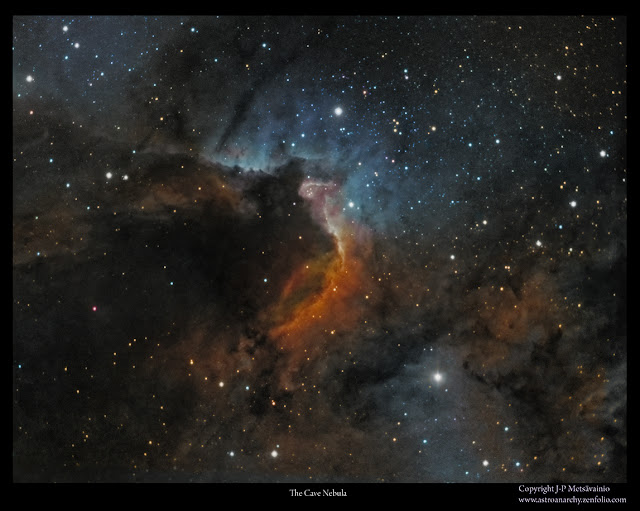COPYRIGHT, PLEASE NOTE
Thursday, April 10, 2025
Sharpless 155, the Cave Nebula
This is one of the targets I’ve been imaging for decades using various equipment—from camera lenses (150–300mm) to large reflecting telescopes ranging from 11" to 14". (My older photos can be seen at end of this blog post)
This time, I used new imaging setup to capture a high-resolution image of Sh2-155.
The seeing conditions weren’t ideal, but I’m fairly happy with the results.
sulfur=red, hydrogen=red and oxygen=blue, this combination is very close to a natural color palette.
Sh2-155—also known as Caldwell 9, Sharpless 155, S155, or LBN 529—is a diffuse nebula located in the constellation Cepheus. It lies within a larger nebula complex that includes emission, reflection, and dark nebulosity. It’s widely known as the Cave Nebula. (Note: The reflection component is not visible in my narrowband image.)
The nebula is approximately 2,400 light-years away. This photo covers an area of about 0.7 × 0.7 degrees of the sky—for reference, the full Moon has a diameter of 0.5 degrees, or 30 arcminutes.
O-III, 6x 1200 s, binned 2x2 = 2h
2008
A photo from 2008, https://astroanarchy.blogspot.com/2008/10/sh2-155-cave-nebula.html
Tuesday, April 8, 2025
A two Frame Panorama of IC 1805, the Heart Nebula
I just published an image of the unnamed pillar-like formation inside the Heart Nebula.
I've created a two-frame mosaic from the new photo, showing its relation to Melotte 15 at the center of the Heart Nebula.
As is usually the case, these pillar-like formations point toward the source of ionization. When radiation pressure (solar wind) push gas and dust away from a newborn star cluster, denser regions of gas can resist this force and begin to collapse. This process leads to the formation of the pillar-like structures. The tips of these pillars can become the birthplace of a second generation of stars within the nebula.
A Hidden Pillar and Melotte 15 in IC 1805, the Heart Nebula
Click for a large image, 3000 x 1700 pixels.


Technical Details and other info can be seen in this blog post
Unnamed Pillar Formation

Technical Details and other info can be seen in this blog post
Strange Pillar like Formation in IC 1805, The Heart Nebula
This is an object in the Heart Nebula that I have captured from time to time. My previous photo was taken in 2012.
This new photo reveals more details, even though the exposure time for H-alpha light was only 5 hours.
The pillar-like formations are typically pointing toward a source of ionization, in this case, the more famous Melotte 15.
I haven't been able to find a name for this beautiful object
 A mapped color image from a light emitted by an ionized elements, sulfur=red, hydrogen=green and oxygen=blue. Original resolution 6500 x 6500 pixels
A mapped color image from a light emitted by an ionized elements, sulfur=red, hydrogen=green and oxygen=blue. Original resolution 6500 x 6500 pixelsO-III, 6x 1200 s, binned 2x2 = 2h
Sunday, March 30, 2025
A Fossil Footprint Nebula, NGC 1491
I have shot this emission nebula in Perseus several times during the years and every time felt that I got more out of it.
I have wide field and mosaic images including the NGC 1491 as well as longer focal length photos with various reflecting telescopes. Some of them are included in the blog post as an exampleClick for a much large image
Click for a much large image
O-III, 6x 1200 s, binned 2x2 = 2h
Wednesday, March 26, 2025
Soul Nebula, IC1848
Click for a large image, 2000 x 2000 pixels

Click for a large image, 2000 x 2300 pixels
Click for a large image, 4600 x 2000 pixels
Hearth and Soul Nebulae at upper right corner
O-III, 6x 1200 s, binned 2x2 = 2h
Monday, March 24, 2025
Melotte 15 in heart nebula, IC 1805
I shot material for this new photo back in February, 10 hours of exposures total for three narrowband color channels. (H-alpha, O-III and S-II)
Click for a large image, 2000 x 2000 pixels
Click for a large image, 2500 x 3200 pixels
O-III, 6x 1200 s, binned 2x2 = 2h
Monday, March 17, 2025
HFG1, a Planetary Nebula in Cassiopeia
I managed to get 17 hours of H-alpha light for the HFG1 and now I'm able to do color photo out of it.
This is a difficult target, very diffused and large, I tried to keep my processing kind of modest to bring out delectate nature of an old and dim planetary Nebula.
Total exposure time is 37 hours and signal wasn't the best possible but I'm happy with this result.
HFG1 in O-III light only
Click for a large image, 2000x2000 pixels
H-alpha, 51 x 1200 s = 17h
Saturday, March 8, 2025
NGC 281, a New Revision
I made a new composition out of my new NGC 281 material, the original composition and technical details can be seen here: https://astroanarchy.blogspot.com/2025/01/new-photo-of-ngc-281.html
This new poster format composition brings out the dynamic nature of this target better.
Click for a large image, 2000x2600 pixels




































